2001 FORD EXPEDITION jump start
[x] Cancel search: jump startPage 178 of 280
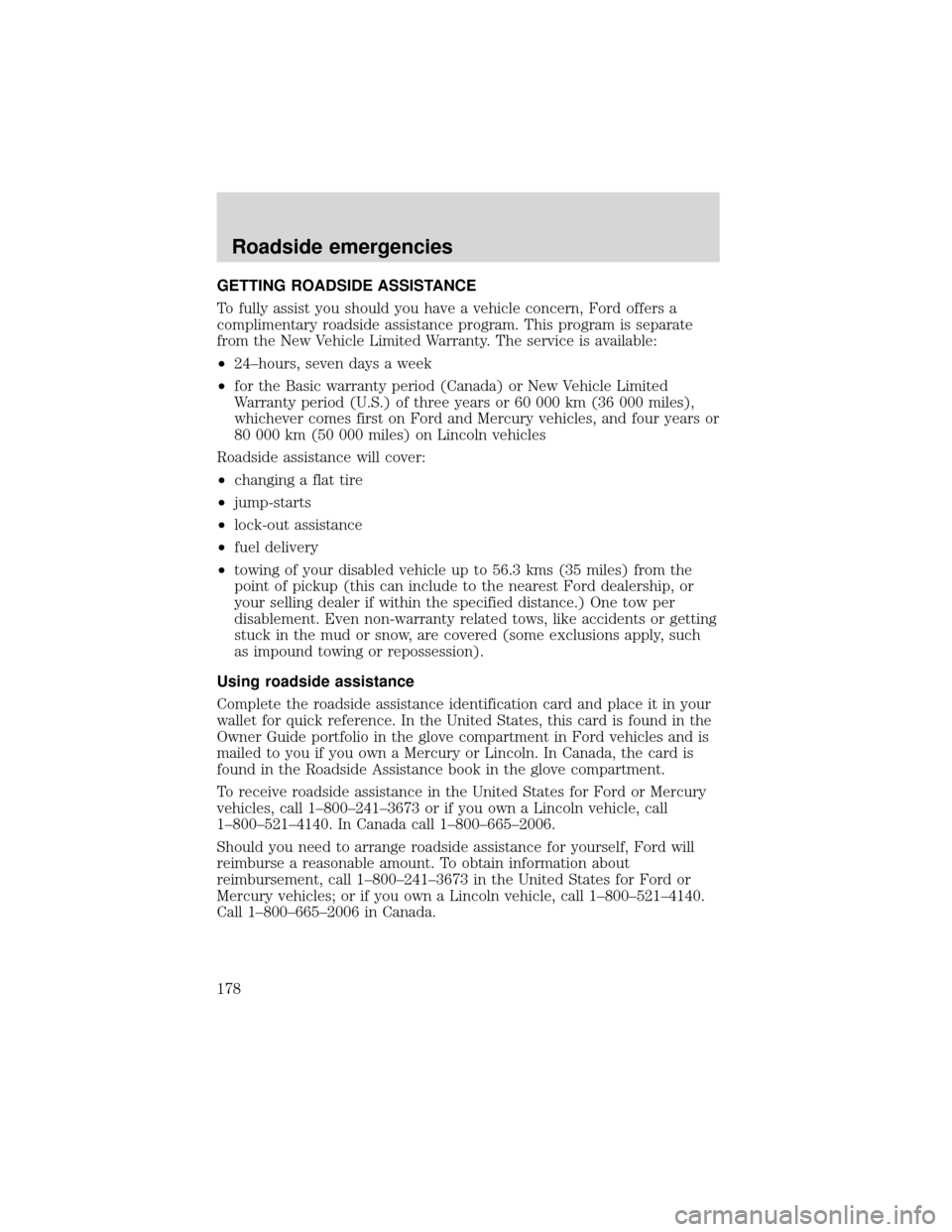
GETTING ROADSIDE ASSISTANCE
To fully assist you should you have a vehicle concern, Ford offers a
complimentary roadside assistance program. This program is separate
from the New Vehicle Limited Warranty. The service is available:
•24–hours, seven days a week
•for the Basic warranty period (Canada) or New Vehicle Limited
Warranty period (U.S.) of three years or 60 000 km (36 000 miles),
whichever comes first on Ford and Mercury vehicles, and four years or
80 000 km (50 000 miles) on Lincoln vehicles
Roadside assistance will cover:
•changing a flat tire
•jump-starts
•lock-out assistance
•fuel delivery
•towing of your disabled vehicle up to 56.3 kms (35 miles) from the
point of pickup (this can include to the nearest Ford dealership, or
your selling dealer if within the specified distance.) One tow per
disablement. Even non-warranty related tows, like accidents or getting
stuck in the mud or snow, are covered (some exclusions apply, such
as impound towing or repossession).
Using roadside assistance
Complete the roadside assistance identification card and place it in your
wallet for quick reference. In the United States, this card is found in the
Owner Guide portfolio in the glove compartment in Ford vehicles and is
mailed to you if you own a Mercury or Lincoln. In Canada, the card is
found in the Roadside Assistance book in the glove compartment.
To receive roadside assistance in the United States for Ford or Mercury
vehicles, call 1–800–241–3673 or if you own a Lincoln vehicle, call
1–800–521–4140. In Canada call 1–800–665–2006.
Should you need to arrange roadside assistance for yourself, Ford will
reimburse a reasonable amount. To obtain information about
reimbursement, call 1–800–241–3673 in the United States for Ford or
Mercury vehicles; or if you own a Lincoln vehicle, call 1–800–521–4140.
Call 1–800–665–2006 in Canada.
Roadside emergencies
178
Page 194 of 280
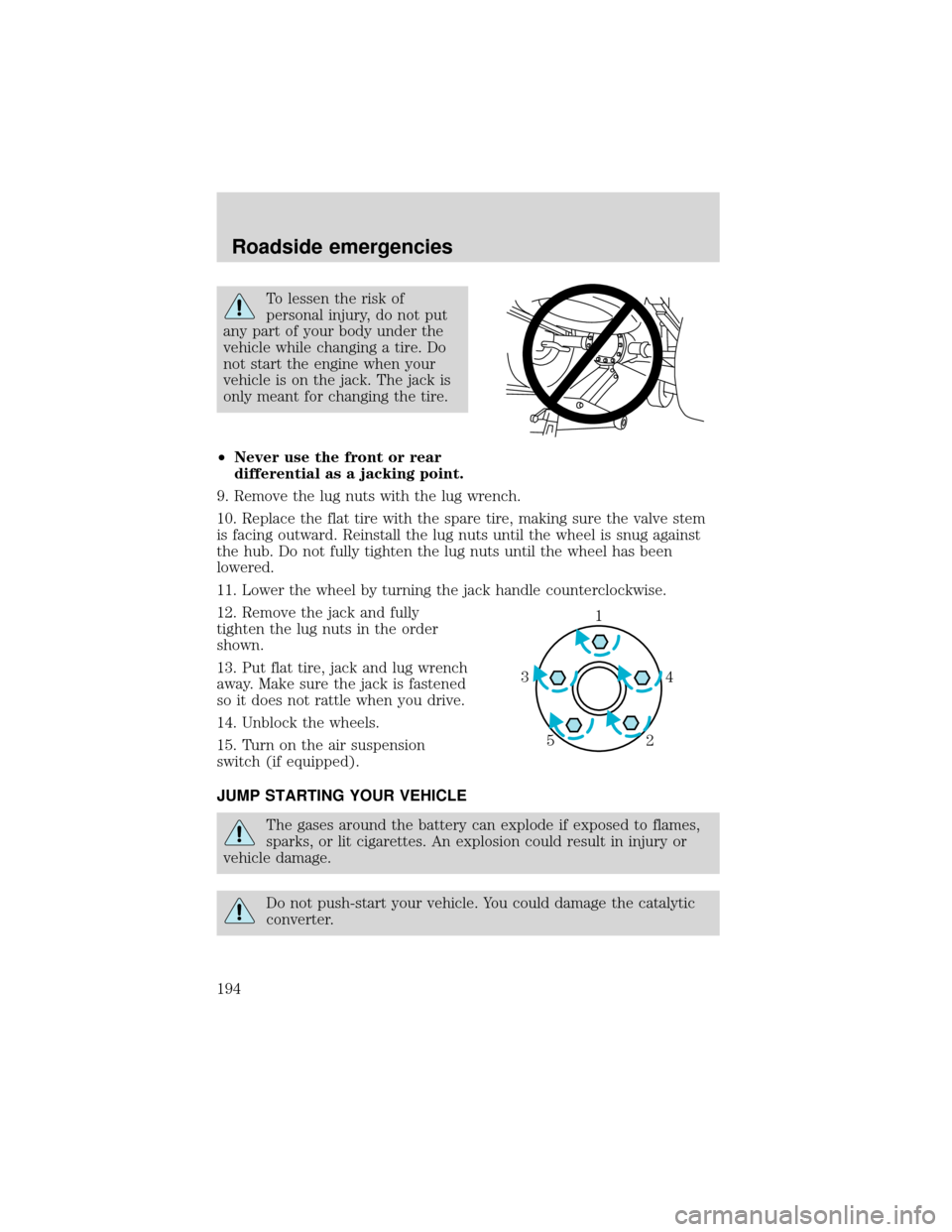
To lessen the risk of
personal injury, do not put
any part of your body under the
vehicle while changing a tire. Do
not start the engine when your
vehicle is on the jack. The jack is
only meant for changing the tire.
•Never use the front or rear
differential as a jacking point.
9. Remove the lug nuts with the lug wrench.
10. Replace the flat tire with the spare tire, making sure the valve stem
is facing outward. Reinstall the lug nuts until the wheel is snug against
the hub. Do not fully tighten the lug nuts until the wheel has been
lowered.
11. Lower the wheel by turning the jack handle counterclockwise.
12. Remove the jack and fully
tighten the lug nuts in the order
shown.
13. Put flat tire, jack and lug wrench
away. Make sure the jack is fastened
so it does not rattle when you drive.
14. Unblock the wheels.
15. Turn on the air suspension
switch (if equipped).
JUMP STARTING YOUR VEHICLE
The gases around the battery can explode if exposed to flames,
sparks, or lit cigarettes. An explosion could result in injury or
vehicle damage.
Do not push-start your vehicle. You could damage the catalytic
converter.
1
4 3
2 5
Roadside emergencies
194
Page 198 of 280
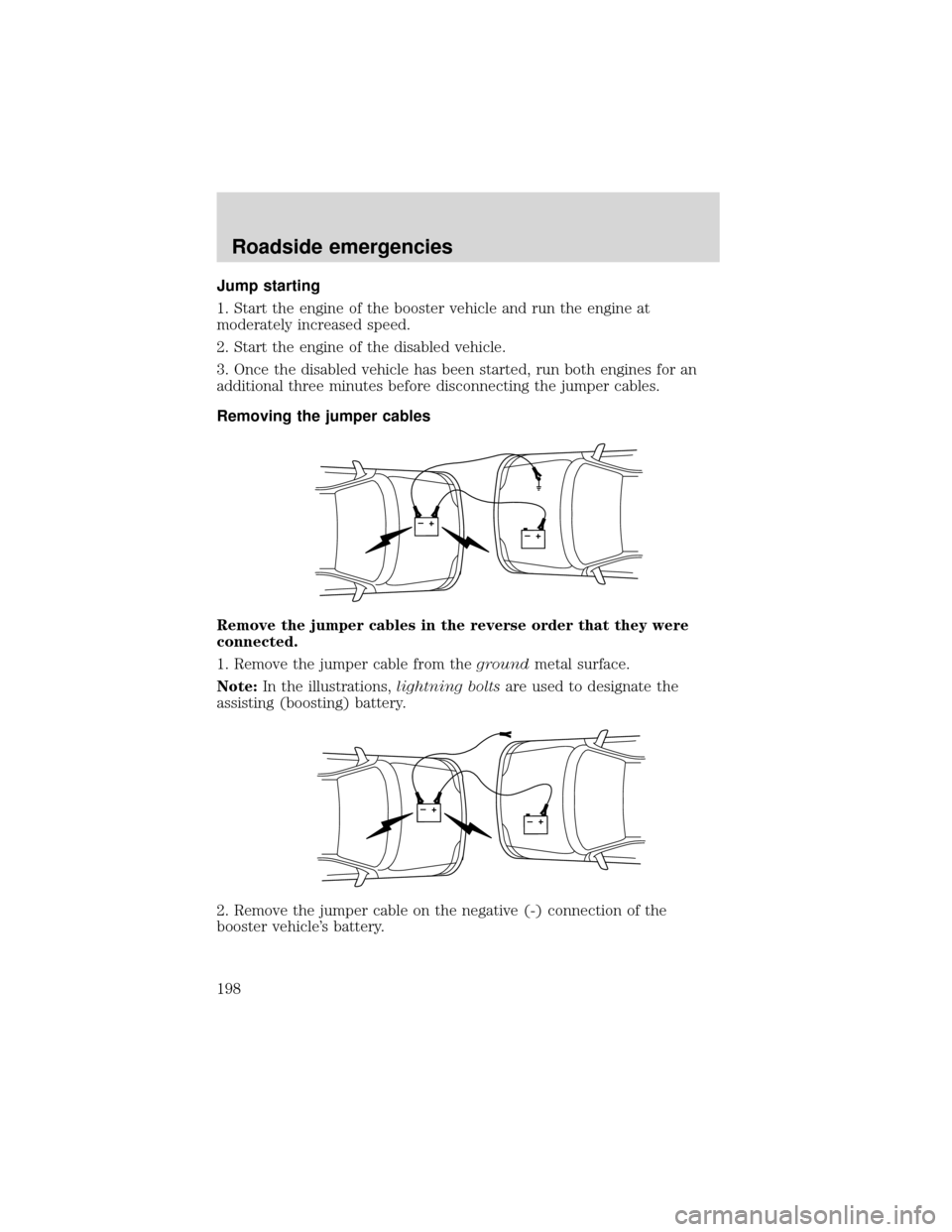
Jump starting
1. Start the engine of the booster vehicle and run the engine at
moderately increased speed.
2. Start the engine of the disabled vehicle.
3. Once the disabled vehicle has been started, run both engines for an
additional three minutes before disconnecting the jumper cables.
Removing the jumper cables
Remove the jumper cables in the reverse order that they were
connected.
1. Remove the jumper cable from thegroundmetal surface.
Note:In the illustrations,lightning boltsare used to designate the
assisting (boosting) battery.
2. Remove the jumper cable on the negative (-) connection of the
booster vehicle’s battery.
+–+–
+–+–
Roadside emergencies
198
Page 199 of 280
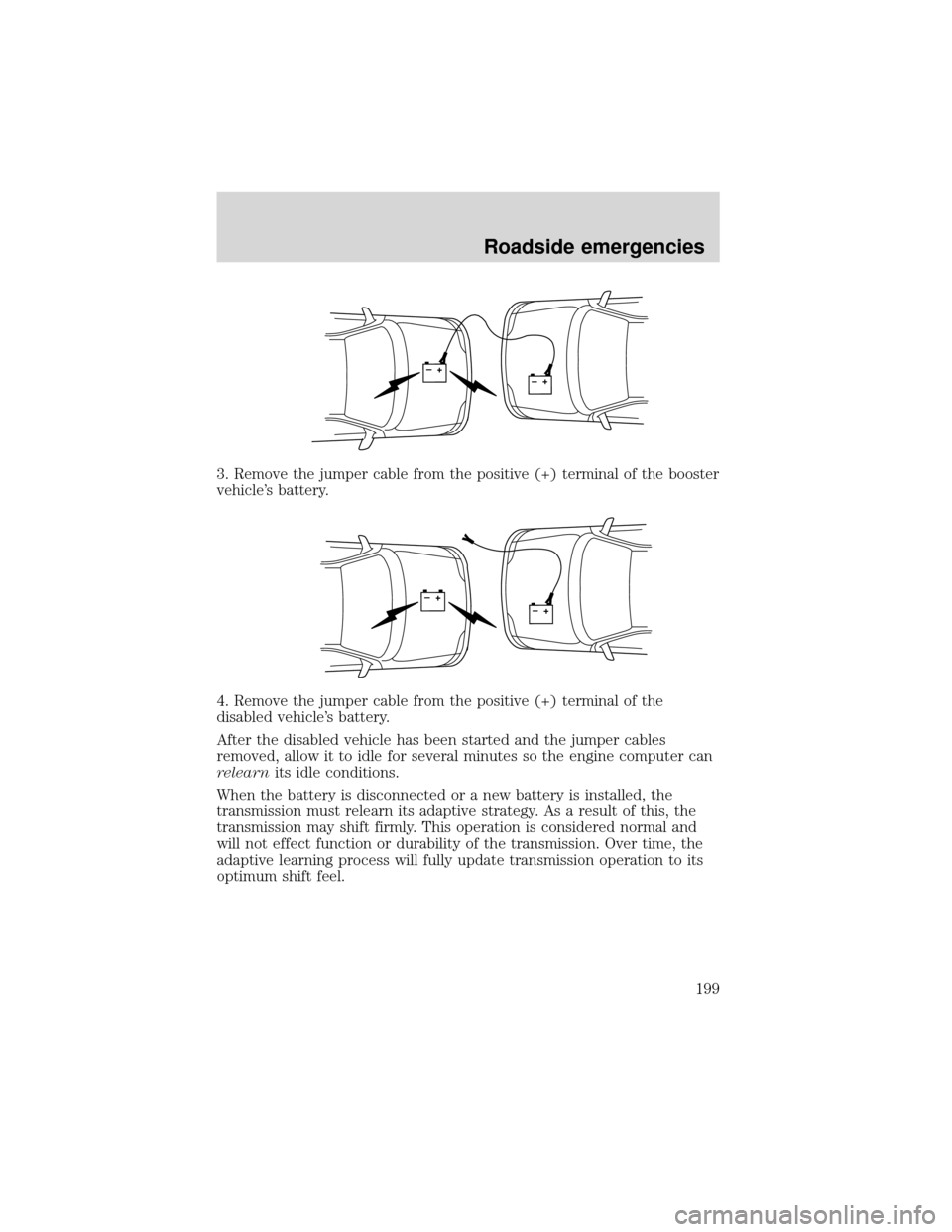
3. Remove the jumper cable from the positive (+) terminal of the booster
vehicle’s battery.
4. Remove the jumper cable from the positive (+) terminal of the
disabled vehicle’s battery.
After the disabled vehicle has been started and the jumper cables
removed, allow it to idle for several minutes so the engine computer can
relearnits idle conditions.
When the battery is disconnected or a new battery is installed, the
transmission must relearn its adaptive strategy. As a result of this, the
transmission may shift firmly. This operation is considered normal and
will not effect function or durability of the transmission. Over time, the
adaptive learning process will fully update transmission operation to its
optimum shift feel.
+–+–
+–+–
Roadside emergencies
199
Page 273 of 280
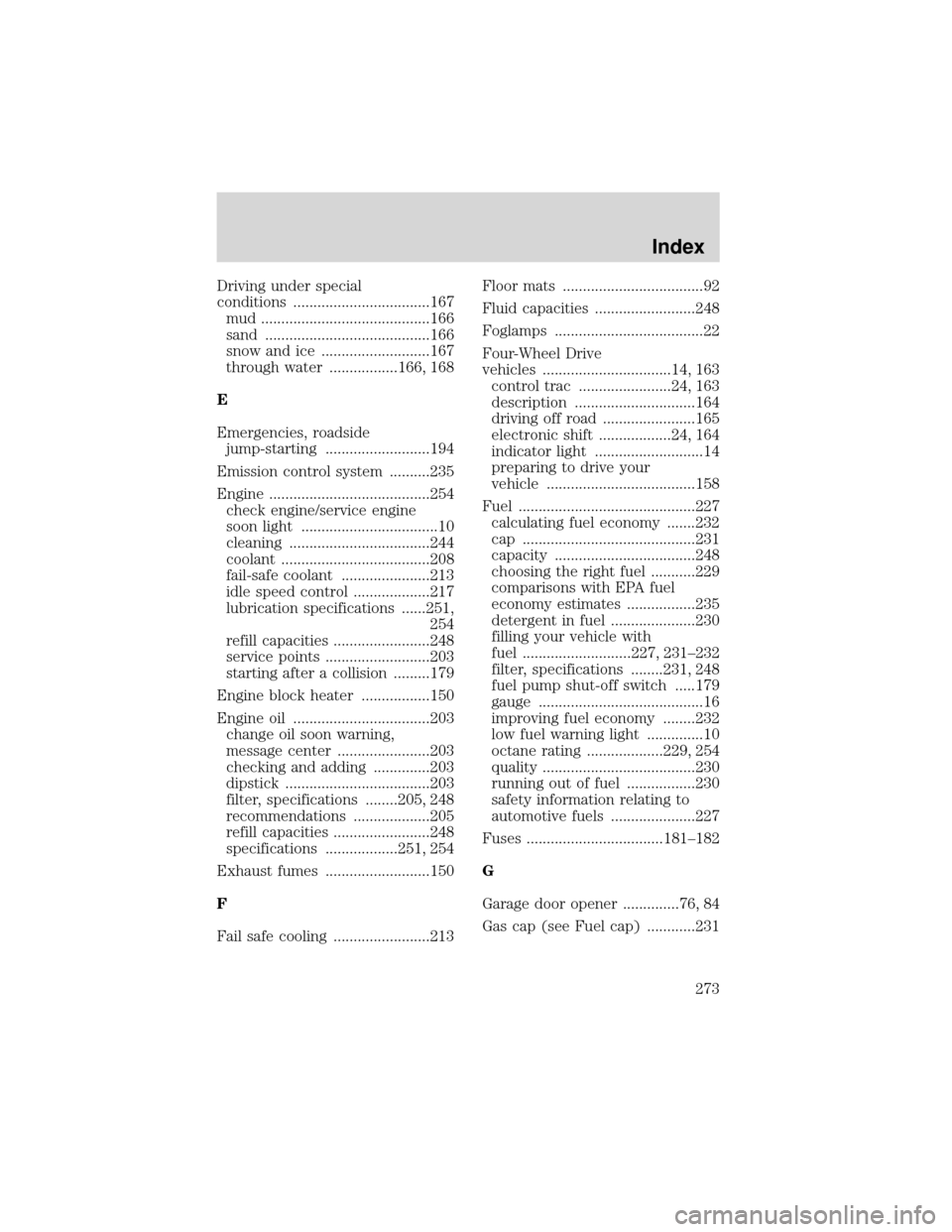
Driving under special
conditions ..................................167
mud ..........................................166
sand .........................................166
snow and ice ...........................167
through water .................166, 168
E
Emergencies, roadside
jump-starting ..........................194
Emission control system ..........235
Engine ........................................254
check engine/service engine
soon light ..................................10
cleaning ...................................244
coolant .....................................208
fail-safe coolant ......................213
idle speed control ...................217
lubrication specifications ......251,
254
refill capacities ........................248
service points ..........................203
starting after a collision .........179
Engine block heater .................150
Engine oil ..................................203
change oil soon warning,
message center .......................203
checking and adding ..............203
dipstick ....................................203
filter, specifications ........205, 248
recommendations ...................205
refill capacities ........................248
specifications ..................251, 254
Exhaust fumes ..........................150
F
Fail safe cooling ........................213Floor mats ...................................92
Fluid capacities .........................248
Foglamps .....................................22
Four-Wheel Drive
vehicles ................................14, 163
control trac .......................24, 163
description ..............................164
driving off road .......................165
electronic shift ..................24, 164
indicator light ...........................14
preparing to drive your
vehicle .....................................158
Fuel ............................................227
calculating fuel economy .......232
cap ...........................................231
capacity ...................................248
choosing the right fuel ...........229
comparisons with EPA fuel
economy estimates .................235
detergent in fuel .....................230
filling your vehicle with
fuel ...........................227, 231–232
filter, specifications ........231, 248
fuel pump shut-off switch .....179
gauge .........................................16
improving fuel economy ........232
low fuel warning light ..............10
octane rating ...................229, 254
quality ......................................230
running out of fuel .................230
safety information relating to
automotive fuels .....................227
Fuses ..................................181–182
G
Garage door opener ..............76, 84
Gas cap (see Fuel cap) ............231
Index
273
Page 274 of 280
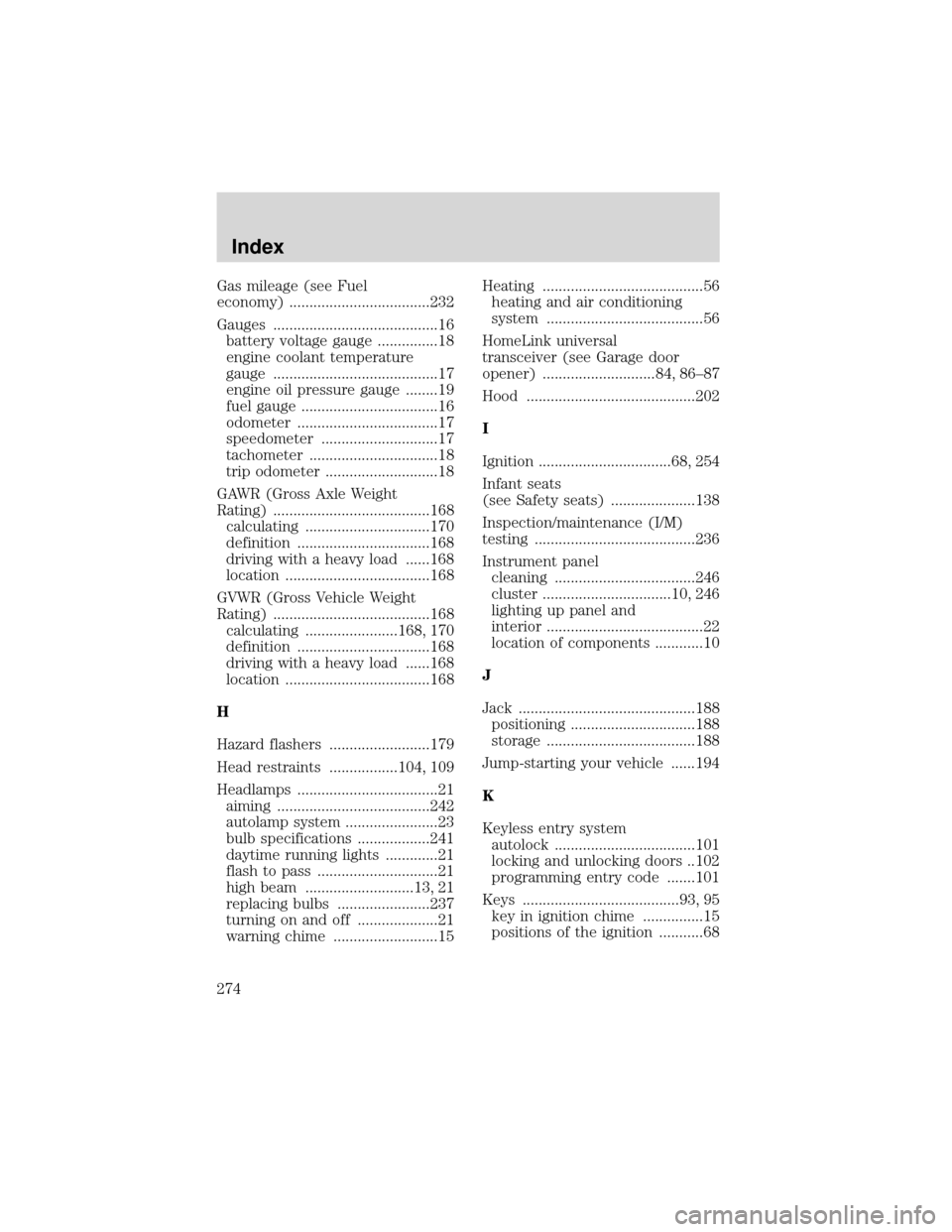
Gas mileage (see Fuel
economy) ...................................232
Gauges .........................................16
battery voltage gauge ...............18
engine coolant temperature
gauge .........................................17
engine oil pressure gauge ........19
fuel gauge ..................................16
odometer ...................................17
speedometer .............................17
tachometer ................................18
trip odometer ............................18
GAWR (Gross Axle Weight
Rating) .......................................168
calculating ...............................170
definition .................................168
driving with a heavy load ......168
location ....................................168
GVWR (Gross Vehicle Weight
Rating) .......................................168
calculating .......................168, 170
definition .................................168
driving with a heavy load ......168
location ....................................168
H
Hazard flashers .........................179
Head restraints .................104, 109
Headlamps ...................................21
aiming ......................................242
autolamp system .......................23
bulb specifications ..................241
daytime running lights .............21
flash to pass ..............................21
high beam ...........................13, 21
replacing bulbs .......................237
turning on and off ....................21
warning chime ..........................15Heating ........................................56
heating and air conditioning
system .......................................56
HomeLink universal
transceiver (see Garage door
opener) ............................84, 86–87
Hood ..........................................202
I
Ignition .................................68, 254
Infant seats
(see Safety seats) .....................138
Inspection/maintenance (I/M)
testing ........................................236
Instrument panel
cleaning ...................................246
cluster ................................10, 246
lighting up panel and
interior .......................................22
location of components ............10
J
Jack ............................................188
positioning ...............................188
storage .....................................188
Jump-starting your vehicle ......194
K
Keyless entry system
autolock ...................................101
locking and unlocking doors ..102
programming entry code .......101
Keys .......................................93, 95
key in ignition chime ...............15
positions of the ignition ...........68
Index
274
Page 276 of 280
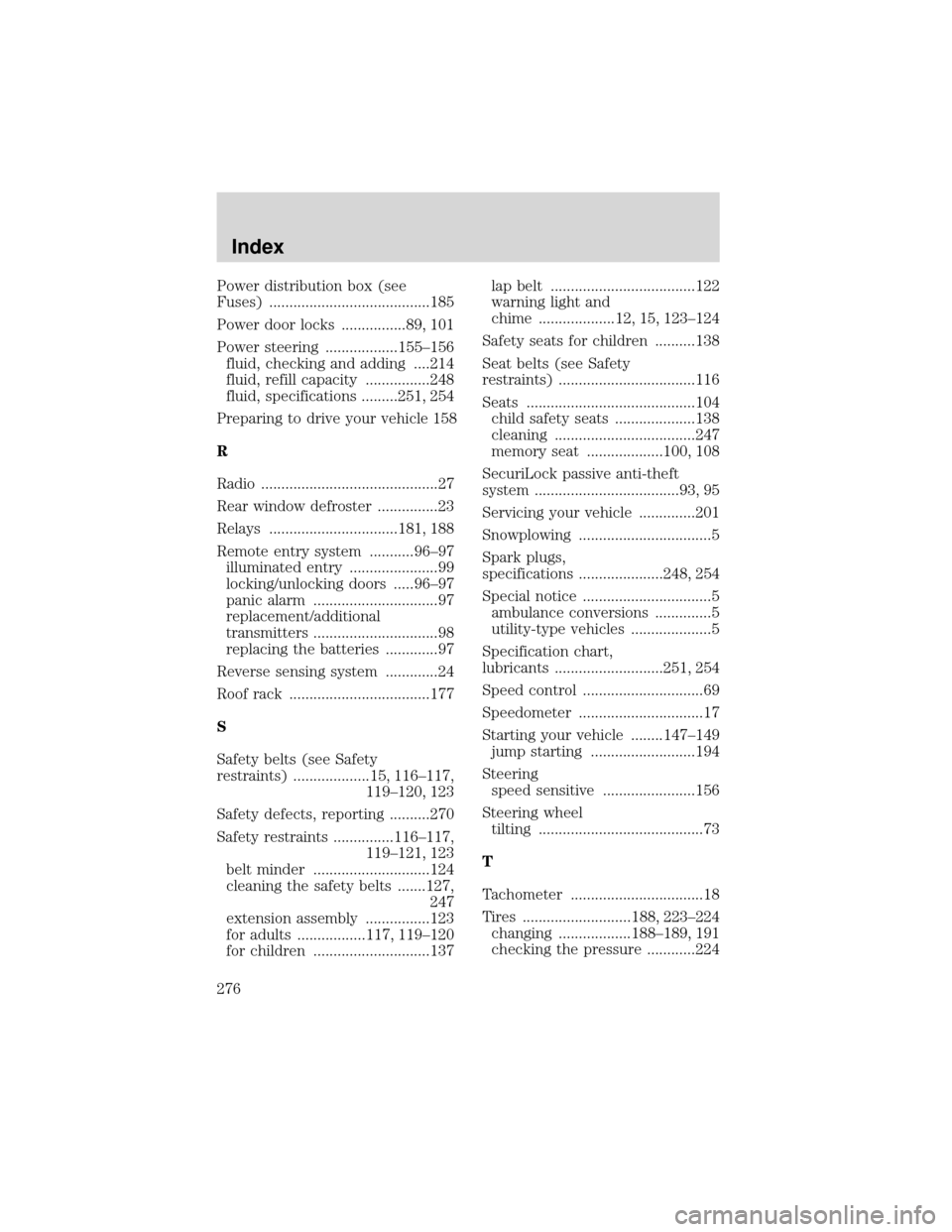
Power distribution box (see
Fuses) ........................................185
Power door locks ................89, 101
Power steering ..................155–156
fluid, checking and adding ....214
fluid, refill capacity ................248
fluid, specifications .........251, 254
Preparing to drive your vehicle 158
R
Radio ............................................27
Rear window defroster ...............23
Relays ................................181, 188
Remote entry system ...........96–97
illuminated entry ......................99
locking/unlocking doors .....96–97
panic alarm ...............................97
replacement/additional
transmitters ...............................98
replacing the batteries .............97
Reverse sensing system .............24
Roof rack ...................................177
S
Safety belts (see Safety
restraints) ...................15, 116–117,
119–120, 123
Safety defects, reporting ..........270
Safety restraints ...............116–117,
119–121, 123
belt minder .............................124
cleaning the safety belts .......127,
247
extension assembly ................123
for adults .................117, 119–120
for children .............................137lap belt ....................................122
warning light and
chime ...................12, 15, 123–124
Safety seats for children ..........138
Seat belts (see Safety
restraints) ..................................116
Seats ..........................................104
child safety seats ....................138
cleaning ...................................247
memory seat ...................100, 108
SecuriLock passive anti-theft
system ....................................93, 95
Servicing your vehicle ..............201
Snowplowing .................................5
Spark plugs,
specifications .....................248, 254
Special notice ................................5
ambulance conversions ..............5
utility-type vehicles ....................5
Specification chart,
lubricants ...........................251, 254
Speed control ..............................69
Speedometer ...............................17
Starting your vehicle ........147–149
jump starting ..........................194
Steering
speed sensitive .......................156
Steering wheel
tilting .........................................73
T
Tachometer .................................18
Tires ...........................188, 223–224
changing ..................188–189, 191
checking the pressure ............224
Index
276